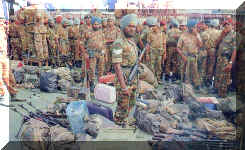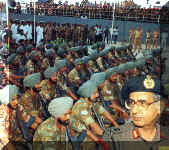The Sri Lankan Interlude 1987-90
Raid on Delft Island
- Details
- Created: 12 October 2006
- Written by L N Subramanian
- Hits: 12667
Introduction
Delft is a small island, near the Jaffna peninsula. It is about 20 kms from Punkudutivu. It was an important transit point for Tamil militants between the south Indian coast and Jaffna peninsula. It was also used as for rest and training by the militants, as it was safe and away from the location of the IPKF. Only boats or helicopters could approach the island. If helicopters were used the militants were warned early enough for them to take their motorized boats or disappear amongst the civilians.

Boat operations were a problem because of the sea state. The small boats of the IPKF could not withstand these conditions. Requisitioning private boats would immediately be conveyed to the Tamil militants. Also the jetty was always watched by the LTTE. With several operations thwarted the IPKF decided to innovate. On 14 Jan 89 Major TS Gill of D Company 5 Para got a tip off from Capricorn sources (anti-LTTE militants) that a group of LTTE personnel led by area commander Ravi were in Delft. It was decided to plan an operation to capture them.
The Plan
With earlier attempts failing Major TS Gill decided to take a risky approach. His group would move out at midnight on fishing boats. These low-powered boats would be used to land on a remote beach. It involved launching the operation from Punkudutivu, an area of shallow water fishing. The fishermen whose boats were to be requisitioned were identified and were to be picked up as the mission began. This way there was no time for them to send any message.
The Raid
During the daytime on 16th Jan troops were inducted into Punkudutivu as if to conduct an operation there. As night approached the pre-identified fisherman were awoken and their boats requisitioned. Four fibreglass boats and 8 OBMs were used. To keep surprise only 1 platoon and 8 Capricorns were assigned to the raid. Another platoon was kept on standby to reinforce at first light after continuing to pretend to conduct operations during the night. As the flotilla set out the men were quietly confident. But soon the rough seas started to create second thoughts, as any capsizing would have detracted from the rescue operation. In addition a Sri Lankan patrol boat spotted them midway to the destination. Normally the IPKF sea ops were passed onto to the Sri Lankan base at Karainagar but this time something had gone amiss. As the boat trained its search light on the bobbing and heaving boats the machine guns were trained on the hapless paras and Capricorns.
For the Sri Lankans there was no way of knowing that this was the IPKF as the presence of Capricorns as well as the fact that the LTTE would dress up as IPKF at times. It was at this critical moment that Major Gill took a chance. He stood on his feet and waved to the Sri Lankan commander. Incredibly the Sri Lankan commander happened to know Major Gill and recognized him from all the liaison meetings. The party was waved on. The troops landed on the eastern shore of Delft just after mid night. Many were sea sick from the journey. The fishing boats were immediately sent back to avoid compromising their mission. The troops first roused Sangripillai the local schoolteacher and a hard-core LTTE sympathizer. He tried to talk his way out of it but was persuaded to lead the way. Still Sangripillai intentionally led the troops to the wrong locations hoping to put off the IPKF. But the troops persisted and eventually Sangripillai lead them to the correct houses.
Still not trusting Sangripillai, Major Gill split his party into three groups along with the Capricorns and decided to simultaneously raid the houses. The stealth and speed took the LTTE by surprise. Ravi fired on the paras but was wounded in the gun battle. He quickly took cyanide and died. His second in command Arimalai tried to do the same but a para quickly knocked him down and captured him. He would subsequently lead the troops to other hideouts. By morning 7 militants were killed/captured. The operations went for another 24 hrs before the troops were satisfied that there were no other militants on the island.
(Adapted from 'Raid on Delft Island' by Brig NS Gill, Combat Journal, April 1991)
Shifting to Jungles
- Details
- Created: 12 October 2006
- Written by Super User
- Hits: 15537
Epilogue
- Details
- Created: 12 October 2006
- Written by IPKF Project
- Hits: 11752
Epilogue
The last units of the IPKF came back in March 1990. They were received by representatives of the Union Govt although the local Govt of Tamil Nadu Chief Minister Karunanidhi stayed way. To their credit the IPKF did not scramble to get out like the Americans in Vietnam. Still it was a sense of dejection, tiredness and disappointment. The IPKF had sacrificed so many of its officers and jawans to set a professional and secular example to the Sri Lankan Armed Forces and a sense of democracy to the Tamils. All this to no avail. The palm fringed towns, farms, placid lakes, beaches and lagoons soon descended into chaos. Within months the NEPC and CVF were in disarray.
The LTTE marched back in. And soon the peace between Colombo and the LTTE collapsed and bitter fighting resumed. The Tamils in Sri Lanka are being put through the meat grinder again. Many prominent Tamils who had so vociferously protested against the IPKF on the LTTE's behalf were gunned down at the first hint straying from the path. The supreme irony is that man who led the LTTE's brilliant fight against the IPKF Mahathayya was branded a RAW spy and tortured to a state of near death. He has not been seen since. It is believed that Mahathayya was done to death on Prabharkaran's orders. Voices now ask for the return of the IPKF but there is no one to listen to them.
IPKF Troops during the final withdrawal from the Island.
The Sri Lankan Armed Forces were in retreat for the first half of the 90s. But since then they have regrouped and driven the war into the LTTE's camp. Jaffna is now back again in Colombo's hands and the LTTE back to the jungles. As this is being written at the end of this century the war is in a stalemate, for a brief period in early 2000, the LTTE hit back with spectacular gains in the Island. Erstwhile strong bastions like Elephant Pass and Chavakacheri in the Sri Lankan army's hands fell in quick succession to the LTTE. For a period, the fate of 22,000 soldiers of the Sri Lankan army seemed to hand in balance. This situation renewed the calls for India to intervene. Wisely, the Indian government stayed out of the conflict.
The Sri Lankan forces have since then, consolidated their positions. The stalemate continues. For the families of the 1,157 Indian Soldiers who died in Sri Lanka, it has been a life of bitter memories. Though the government has done its best to rehabilitate those affected by the conflict, It is pretty clear that unlike the Kargil conflict, where the entire country's population rallied behind the armed forces and the families of those who died defending Indian territory, there has been little or no awareness among the Indian public about the sacrifices made by these families. In short as one correspondent wrote "They died fighting someone else's war, remembered only by their families."
Unlike the Kargil war where the bodies of the dead soldiers were shipped back to their homes and the funeral rites were carried out with full military honours, the families of the martyrs in Sri Lanka received only the ashes. The practice then was to ship the bodies of the officers home, but the bodies of the other soldiers were cremated on the Sri Lankan soil itself. Amongst the Indian Army their is a marked reluctance to talk of the Sri Lanka episode. Only a couple of books have been written by officers who served there. The College of Combat did study the conflict and accordingly rewrite many of the tactics. But what is needed is an effort understand and highlight the political, military and intelligence bungling to the general public so that the sacrifice of the many men would not go in vain. This website is hopefully a small part of that process.


